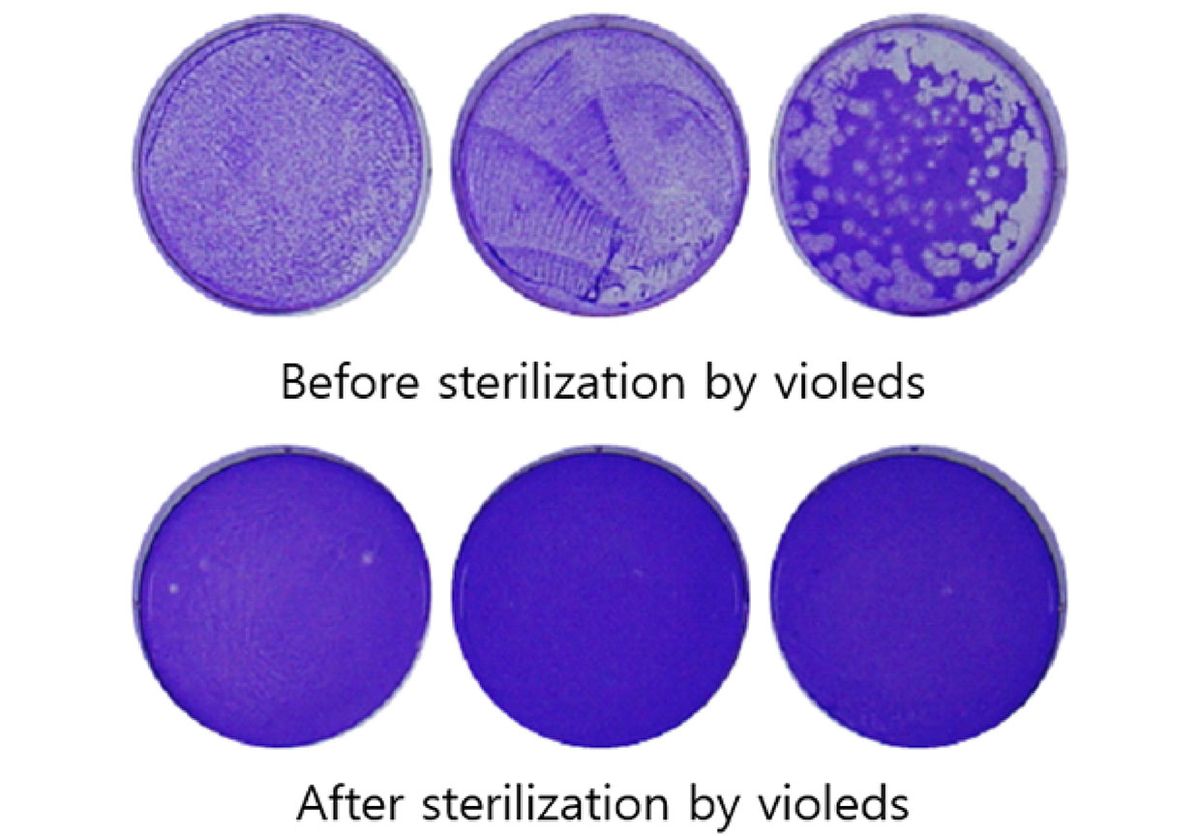Robots and stranger machines have been using a particular band of ultraviolet light to sterilize surfaces that might be contaminated with coronavirus. Those that must decontaminate large spaces, such as hospital rooms or aircraft cabins, use large, power-hungry mercury lamps to produce ultraviolet-C light. Companies around the world are working to improve the abilities of UV-C producing LEDs, to offer a more compact and efficient alternative. Earlier this month, Seoul Viosys showed what it says is the first 99.9 percent sterilization of SARS-COV-2, the coronavirus that causes COVID-19, using ultraviolet LEDs.
UV LEDs are deadly to viruses and bacteria, because the 100-280 nanometer wavelength C-band shreds genetic material. Unfortunately, it’s also strongly absorbed by nitrogen in the air, so sources have to be powerful to have an effect at a distance. (Air is such a strong barrier, that the sun’s UV-C doesn’t reach the Earth’s surface.) Working with researchers at Korea University, in Seoul, the company showed that its Violed LED modules could eliminate 99.9 percent of the SARS-COV-2 virus using a 30-second dose from a distance of three centimeters.
Unfortunately, the company did not disclose how many of its LEDs were used to achieve that. Assuming that it and the university researchers used a single Violed CMD-FSC-CO1A integrated LED module, a 30-second dose would have delivered at most 600 millijoules of energy. This is somewhat in-line with expectations. A study of UVC’s ability to kill influenza A viruses on N95 respirator masks indicated that about 1 joule per square centimeter would do the job.
While the 3-centimeter distance may work in tight spaces such as an air filter or water purifier—products that UV LEDs already serve—it won’t do for hospital-room-sterilizing robots. The GermFalcon airplane cabin sterilizer, for example, needs to bathe an aircraft cabin in light strong enough to kill the virus in seconds from a distance of about 30 centimeters, its inventor Dr. Arthur Kreitenberg told IEEE Spectrum last month. Today’s UV-C LEDs can’t produce enough light for the job, he said. But with the GermFalcon’s mercury lamps, which measure output in watts, that power comes at a large cost in energy and bulk. The system’s iron-phosphate battery pack has to deliver 100 amperes to produce the needed UV power.
The potential advantages of UV-C LEDs over mercury lamps include a lack of toxic mercury, better robustness, longer lifetimes, faster startup, and emission at a diversity of wavelengths, which may aid in their germicidal role. But it’s their potential for efficiency that could be most important.
At the moment, mercury lamps have a better wall-plug efficiency—electrical power in versus optical power out—than the UV-C LEDs on the market now. The wall plug efficiency of today’s UV-C LEDs is just 2.8 percent, with 3.3 percent-efficient systems in the R&D phase, according to Jae-hak Jeong, technical research fellow and vice president at Seoul Semiconductor, Seoul Viosys’ parent company. Mercury lamps boast 15-35 percent.
The mercury lamp’s advantage is not expected to last, because researchers expect UV-C LEDs to follow a similar efficiency improvement path to solid-state lighting’s blue LEDs. However, UV-C devices have a long way to go. Blue LEDs typically have an internal quantum efficiency, the fraction of electrons injected into a specific part of the LED that result in the generation of photons—of about 90 percent. For UV-C it’s 30-40 percent, says Jeong. For external quantum efficiency—the ratio of photons emitted to electrons passing through the LED—the comparison is even worse. About 70 percent for blue LEDs versus 10-16 percent for UV-C devices.
According to Jeong, boosting these figures will take improvements both to fabrication process and to epitaxy, the growth of the semiconductor crystal that the LEDs are made upon. These LEDs are usually built by using epitaxy to grow a layer of crystalline aluminum nitride atop a sapphire wafer. Defects in the crystal are a main limiter to LED performance, so improving the epitaxy process is one path toward brighter LEDs.
Samuel K. Moore is the senior editor at IEEE Spectrum in charge of semiconductors coverage. An IEEE member, he has a bachelor's degree in biomedical engineering from Brown University and a master's degree in journalism from New York University.



